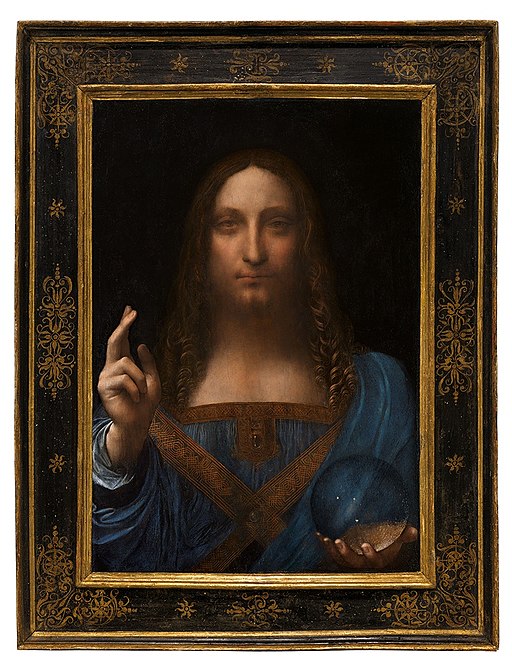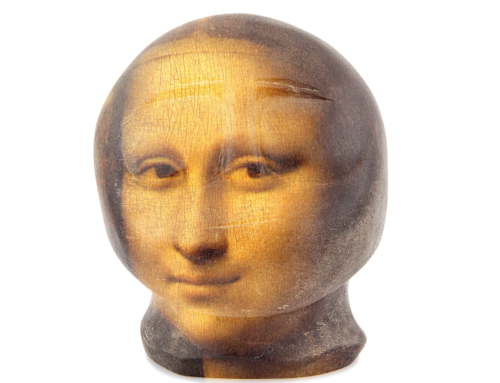“Going once…going twice…sold,” said the auctioneer, as he pounded the gavel and the spectators gasped at Christie’s auction last week.

“Salvator Mundi” Léonard de Vinci, via Wikimedia Commons
Imagine, if you can, $450.3 million dollars – almost half a billion dollars – for Salvator Mundi, a painting by Leonardo da Vinci that had been extensively restored and had even raised a few doubts about authenticity. Oh, the irony of it all. Salvator Mundi means Savior of the World. Enough money that would save at least a portion of the world in dire need of food or medicine or education, or reeling from natural disasters of hurricanes or earthquakes, goes for a painting that won’t save anyone.
But that’s not the irony I mean. Nor is the record-setting price per se, since enormous sums of money are squirrelled away by a few individuals who could afford to buy a painting of such rarity and interest. As Walter Isaacson tells us in his fascinating new biography, Leonardo da Vinci, Leonardo was an unsurpassed genius of the ages. He blended science and art with insight centuries ahead of his time in painting and engineering and anatomy and astronomy and…I don’t know where to end his observations and contributions – they are overwhelming. He even compared the relative flapping speed of the wings moving up or down in different species of birds, and applied his findings, along with his anatomical studies, in attempt to engineer human flight. His paintings are treatises on light and shadows, and as well as being superb art, tell stories uniting the earth and mankind. His detailed diagrams of human anatomy are inseparable from art. Read the book. I’m just touching on Leonardo. Admire the man. In Isaacson’s words, Leonardo was “the epitome of the universal mind, one who sought to understand all of creation, including how we fit into it.”
There’s a good case to be made that Salvator Mundi – recently discovered after 500 years and one of the few remaining paintings by Leonardo – is worth whatever someone can pay. Preservation and history are priceless and as important for culture as the foundation of a skyscraper is for stability.
Although the painting raises issues – for example, why doesn’t the clear crystal orb held by Jesus distort the cloth behind it if Leonardo was so obsessed by accurate observations (Leonardo claimed that nothing is distorted in the hands of Jesus), or did any other hands contribute to Salvator Mundi, either when it was first made or being restored – these questions are at least consistent with the ambiguity portrayed in Leonardo’s art. He comingled reality and imagination, blurring contours and edges in a borderless world of art called sfumato. He painted what the eye saw from different perspectives, not a close-up, precise image that a machine would portray. He stretched observations into imaginative fantasy that became goals. Ambiguity was Leonardo’s medium in art, nowhere better illustrated than in Mona Lisa’s famous smile.
Would Mona Lisa have the same fascination if we knew what she was thinking or feeling?
The irony I’m talking about, therefore, is not the extraordinary price realized for the painting. The irony is that the sale of Salvator Mundi delivered a counterproductive message with respect to Leonardo’s productive life. Salvator Mundi was subjected to an intensive, international marketing effort that shined a brilliant spotlight on the auction, which resulted in such a spectacular result. Of course, it wasn’t marketing alone that brought the price.
Leonardo was one of the greatest geniuses of all time, and he did market himself. He sought patrons (often with limited success) and, like other creative artists, craved recognition. He was competitive (especially with his rival Buonarroti Michelangelo), and loved glamor and pageantry and fancy dress, as a court dandy charming everyone, or so it seems from Isaacson’s book.
But don’t be fooled: what ultimately made Leonardo the artist he was had nothing to do with marketing and was not defined by monetary values. Indeed, he struggled for funds and at times was never compensated. He buried himself in his work, whether painting or engineering machines of war or flight, or irrigation, or city planning, so deeply, and was distracted by new questions that he raised himself so often, that he seldom finished anything.
He defied marketing by procrastinating. No one could count on his delivering anything. Consider just one example: he worked on Mona Lisa for seventeen years and died at 67 with it in his bedroom, along with other masterpieces, which were never delivered as promised!
Preservation and history are priceless and as important for culture as the foundation of a skyscraper is for stability.
The question that comes to mind is would Leonardo have created the works he did if he had shot for deadlines and concentrated on self-promotion? Many of his greatest works (for example, Adoration of the Magi and Saint Anne) were what Isaacson calls “unfinished perfections.”
If Leonardo wasn’t distracted, he always found more to do on any project and, in that sense, it never finished. What a wonderful concept – unfinished perfection. Isn’t that an appropriate description of our lives – perfection to have lived at all, and unfinished when we die? Are any truly creative acts ever finished? Unfinished leaves space for imagination – fantasy and experimentation – hallmarks of Leonardo, and the lifeblood of creativity. How different from today’s world, epitomized by the marketing that led to the extraordinary sale and success of Salvator Mundi.
I wonder what would happen today if we finished little of what we started, or made it too ambitious to continue, as Leonardo often did, or left it incomplete to pursue another project because of our curiosity? Research grants stretching the imagination, or overly ambitious, or proposed strictly to satisfy curiosity would not be funded today. We’d be out of work if we followed Leonardo’s way: a scientist would lose support, a professor would be denied tenure in academia, or a researcher would be fired from industry if his bright ideas never materialized.
The irony of Salvator Mundi, then, is that Leonardo’s success, judged by Christie’s record sale (due in large part to marketing he never would have done), reflects a creative life that we wouldn’t permit today. Leonardo’s success today is due to a creative lifestyle that has been lost in modern times. Now that’s irony!
Leonardo never published! He did, however, keep meticulous unedited, disorganized notes – over seven thousand pages of descriptions, diagrams, lists and thoughts – his mind on paper, his curiosity on his sleeve. Compare that with today, when success in science and art and engineering, Leonardo’s worlds, is measured by publications and sales and function, respectively.
Maybe there’s a lesson there for us, but I’ll let you decide exactly what that might be for you, because for every argument there’s a counter-argument, for every era, there’s a new set of rules. If Leonardo had published his amazing observations and ideas, he may well have been credited with being the father of Newtonian physics and modern anatomy and astronomy and the Wright brothers, instead of having the good fortune that his copious notes were preserved and we can appreciate him retroactively.
We’d be out of work if we followed Leonardo’s way: a scientist would lose support, a professor would be denied tenure in academia, or a researcher would be fired from industry if his bright ideas never materialized.
But if he had followed the present criteria for success, would he have had time and freedom to be the Leonardo da Vinci, the artist that painted Salvator Mundi that sold for nearly half a billion dollars?






Leave A Comment